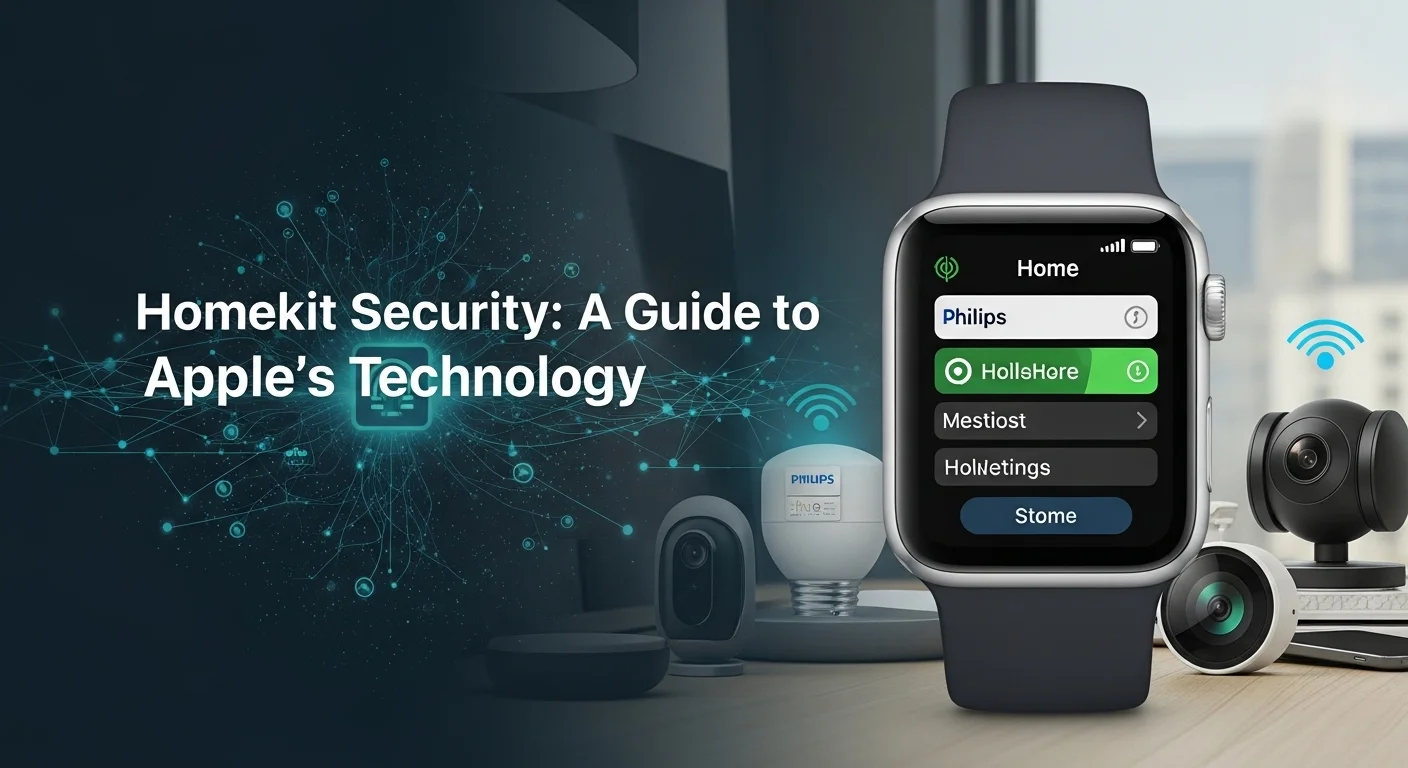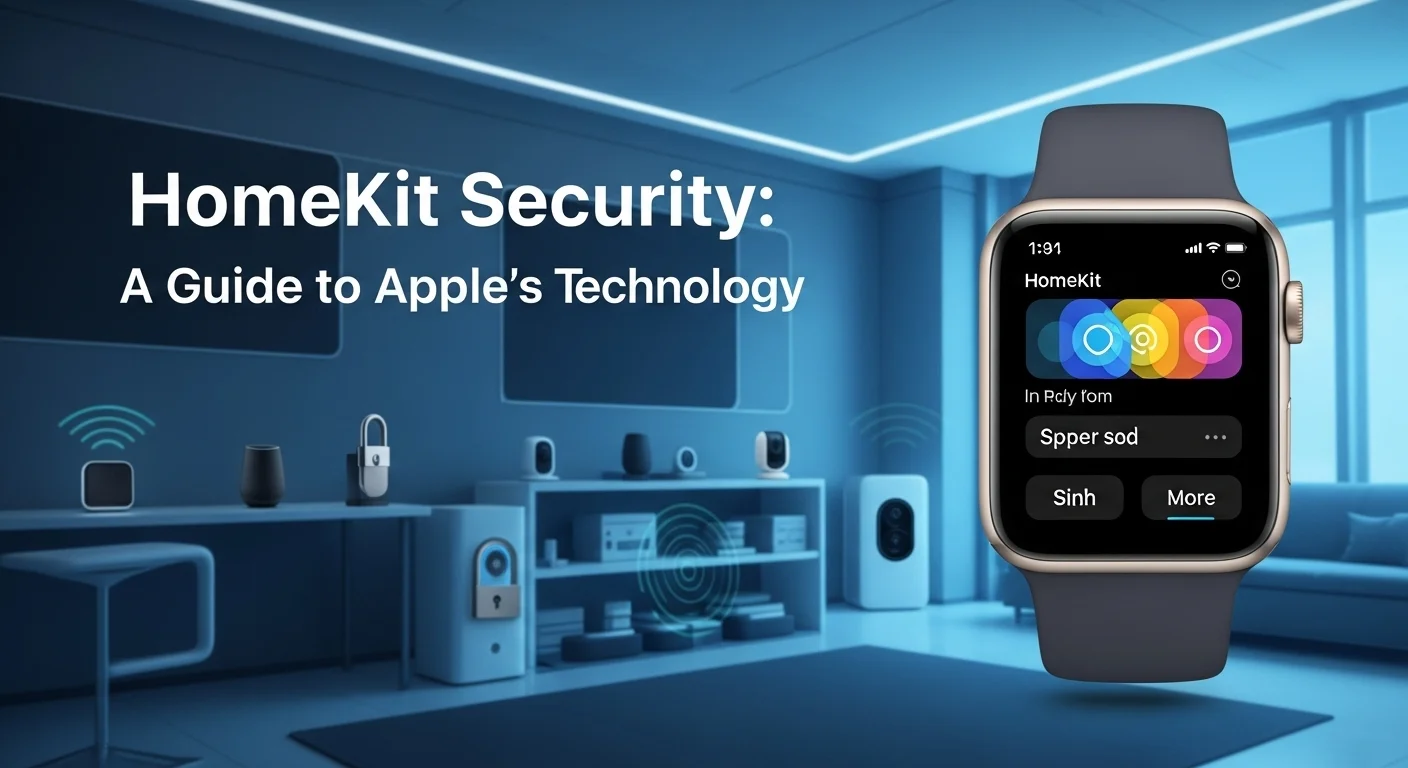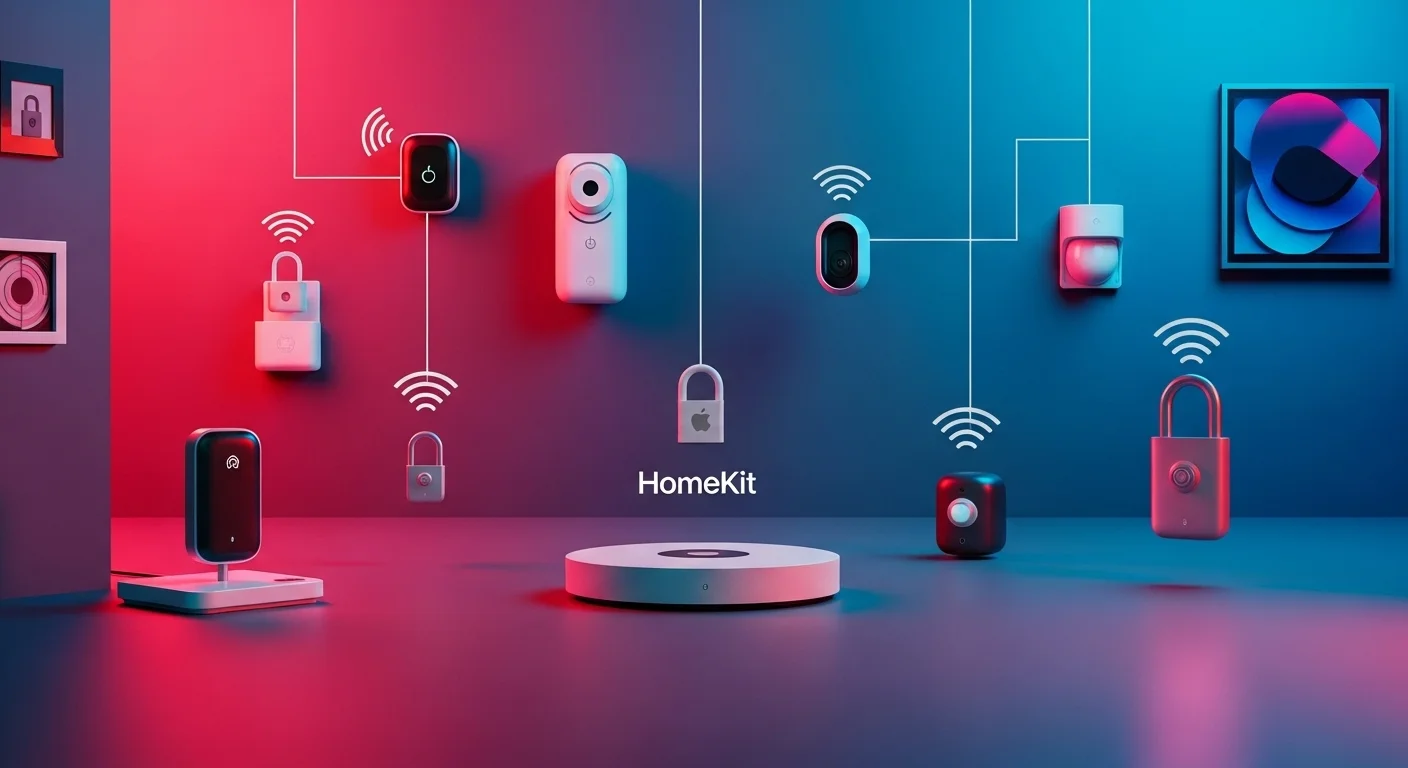Is Apple HomeKit Really Secure? A Guide for Your Home & Business

Executive Summary
In a world full of smart gadgets, keeping our personal and business lives private is more important than ever. I've seen firsthand how many smart home platforms can be leaky with our data. That's where Apple's HomeKit framework really shines. It was built from the ground up with a focus on privacy, using powerful security layers. This guide is my personal take on how it all works. We'll walk through its core features like end-to-end encryption, the strict 'Made for iPhone' certification, and why a HomePod or Apple TV is the secure heart of your home. We'll explore game-changers like HomeKit Secure Video, which analyzes video inside your home before securely storing it, and HomeKit Secure Routers that wall off your accessories from the wider internet. For business owners, I'll explain how an Apple-based system can offer simple, yet incredibly secure, automation for your office. This is your straightforward guide to using Apple's ecosystem to make your space smart without sacrificing safety.
Table of Contents
Table of Contents
- What is HomeKit and Why Does Its Security Matter?
- The Three Pillars of HomeKit Security
- Next-Level Protection: Secure Video and Routers
- HomeKit in the Office: A Secure Foundation for Business
What is HomeKit and Why Does Its Security Matter?
Our homes and offices are brimming with smart devices. From lights that greet us to cameras that watch over our property, the convenience is fantastic. But I've always told my clients: every connected device is a potential door left ajar for trouble. In this landscape, Apple's smart home platform, HomeKit, stands out as a fortress built for privacy. Understanding its security isn't just for tech geeks; it's essential for anyone who values their privacy in our connected age. Apple’s whole philosophy is 'privacy by design,' which means your data is protected from the very start. It’s a refreshing change in an industry where data breaches feel like a weekly occurrence.
So, what is HomeKit? Simply put, it's a framework that lets smart accessories from different brands speak the same secure language. What makes it special, and the reason I trust it in my own home, are its non-negotiable security rules. The system is built on a few core beliefs: encrypt everything, process data locally whenever possible, and verify every device. All the chatter between your iPhone, your smart lock, and your Apple TV hub is completely encrypted. This means no one—not even Apple—can peek at that data. Think about that for a second. When you ask Siri to unlock your front door, that command is a secure secret between you and your lock. That’s a world of difference from other platforms that might process that command on a company server, creating a target for hackers.
The Three Pillars of HomeKit Security: Encryption, Certification, and Hubs
To really get why HomeKit is so solid, you need to understand its three main pillars. First is that end-to-end encryption. When you add a new gadget, a secure digital handshake creates a unique key. From then on, all conversations are locked down tight with powerful cryptography. This protection extends from your phone right to the device itself. When you're away from home, this secure message is passed through your home hub—like a HomePod or Apple TV—which acts as a trusted courier, never opening the mail it carries.
The second pillar is the MFi (Made for iPhone) certification program. For a product to get that coveted 'Works with Apple HomeKit' sticker, its maker has to meet Apple's strict security and performance standards. I've seen how this process weeds out poorly made, insecure products that could otherwise put your whole network at risk. This curation provides real peace of mind, assuring you that any certified device you add to your system has been properly vetted.
The third pillar is the home hub. Your Apple TV or HomePod is more than just an entertainment device; it's the secure command center of your smart home. It runs your automations, lets you control things remotely, and, crucially, handles the heavy lifting for advanced security features. When you issue a command from a coffee shop miles away, it travels securely to your hub, which then talks to the device on your private home network. This design drastically shrinks the chance of an attack. For something like HomeKit Secure Video, the hub does all the smart analysis—like spotting the difference between a person and a pet—right there in your living room. Only then is the clip encrypted and sent to the cloud. This 'local first' approach is a cornerstone of Apple's privacy promise.
Next-Level Protection: Secure Video and Routers
Beyond the basics, Apple has developed features that truly set its security apart. The first is HomeKit Secure Video (HSV). I'll never forget the peace of mind I got when I switched my nursery camera to HSV. Traditional security cameras often send video to company servers for analysis, which always made me uneasy. HSV flips that model on its head. A compatible camera streams video directly to your local home hub. That hub uses its own processing power to analyze the footage privately. If it sees something you've asked it to record, like a person, it encrypts the video end-to-end and uploads it to your iCloud account. The best part? The keys to unlock that footage are only on your devices, so no one else can see it, and it doesn't even count against your iCloud storage limit.
The second advanced feature is HomeKit Secure Routers. This is a brilliant idea that creates a personal firewall for each of your accessories. With a compatible router, you can decide exactly how each smart device communicates with the internet. The 'Restrict to Home' setting is the most secure; it completely blocks an accessory from accessing the internet, letting it talk only to your home hub. I use this for my smart plugs and light bulbs. It makes it impossible for them to be hijacked and used in a wider internet attack. It’s a forward-thinking approach that locks down your smart home even further.
HomeKit in the Office: A Secure Foundation for Business
While we often talk about smart homes, these security principles are incredibly valuable for small businesses. A retail shop, a small office, or a design studio can use HomeKit for everything from managing door locks to secure video surveillance. The biggest win for a business is getting robust security that's also easy to manage. You don’t need an IT degree to set it up. You can grant employees access with their iPhones and easily revoke it when they leave.
For a business, a security breach is a nightmare. Many so-called 'commercial' IoT devices have the same security holes as cheap consumer gadgets. By building on HomeKit, a business is essentially piggybacking on Apple's massive investment in security engineering. The encryption protects sensitive data, like who is coming and going. HomeKit Secure Video offers a private surveillance system without risky third-party cloud services and monthly fees. And a secure router can prevent a hacked smart TV in the breakroom from threatening the main business network. When choosing a security system, it's not just about a single camera or lock; it's about investing in a private, integrated platform that protects your business from the ground up.

A Deeper Dive: HomeKit Security for Business & Tech Solutions
For those of us who really want to get into the nuts and bolts, understanding the technology behind HomeKit's reputation is key. Whether you're a business owner making a security decision or a tech enthusiast building the ultimate smart home, the details matter. The platform's security isn't just one feature; it's a carefully woven fabric of cryptography, hardware and software synergy, and a thoughtfully designed network architecture. Let's pull back the curtain and see how to build a truly secure smart environment.
A Technical Deep Dive into HomeKit's Cryptographic Framework
Every secure system starts with strong cryptography, and Apple HomeKit uses several layers to guarantee your privacy. It all begins with pairing. When you scan that eight-digit code on a new accessory, you're kicking off a process called Secure Remote Password (SRP). It's a clever way for your phone and the accessory to prove their identities and create a shared secret key without ever sending the code itself over the air. It’s like creating a secret handshake that only they will ever know.
After that, every conversation is protected with unique, per-session encryption keys. This means even if a hacker could somehow capture the data from one command, it would be useless for decoding any past or future commands. The platform uses modern, powerful ciphers like ChaCha20-Poly1305, which not only scramble the data but also verify that it hasn't been altered along the way. When you're controlling devices from outside your home, these already-encrypted conversations are wrapped in another secure tunnel to your home hub. It’s like putting a locked box inside another locked box. This meticulous design is what makes the whole system so trustworthy.
Choosing the Right Hardware: Building Your Ideal Secure System
A secure system is only as strong as its weakest link. Assembling a top-tier security setup means choosing the right gear. I've tested a lot of devices over the years, and here's what I look for:
- Cameras: For me, cameras that support HomeKit Secure Video (HSV) are non-negotiable. Brands like Logitech, Eve, and some from Eufy and Aqara are my go-to recommendations. They let your home hub do the private video analysis, which is the most important feature for privacy. When choosing, think about its viewing angle, night vision quality, and where you'll place it.
- Locks: A smart lock is a huge security component. Models from August, Schlage, and Yale integrate beautifully, allowing for secure remote control, temporary guest keys, and smart automations like locking up when everyone has left. The encrypted commands prevent thieves from digitally picking your lock.
- Sensors: Door, window, and motion sensors are the eyes and ears of your system. Companies like Eve and Aqara make tiny, reliable sensors that can trigger alarms, lights, or notifications. Because they're on the secure HomeKit network, their signals are protected from the kind of jamming attacks that can defeat older wireless security systems.
- Routers: For maximum security, a HomeKit Secure Router from a brand like Eero or Linksys is a game-changer. It firewalls each accessory, so if a vulnerability is ever found in your smart TV, it can't be used to attack your work computer on the same network.
When you're shopping, always look for that official "Works with Apple HomeKit" logo. It's your guarantee that the product has passed Apple's tough security and privacy exams.
Configuration and Management: Best Practices for Business and Power Users
Getting the setup right is just as important as buying the right hardware. For a business using HomeKit, this means being deliberate about who has access and how automations work.
- User Access Control: In the Home app, you can invite people to control your home or office. It's crucial to give them the right level of permission. Can they view cameras? Can they add or remove devices? Regularly review these permissions, especially in a business setting, and remove access for former employees instantly.
- Secure Automations: Automations are where the magic happens, but they need to be smart. For example, an automation that unlocks the front door whenever any motion is detected is probably a bad idea. A better, more secure automation would be: 'When the last person leaves the office, arm the security system, turn off lights, and lock all doors.' HomeKit has different security states (Away, Home, Night, Off) that let you create smart rules for each scenario.
- Network Segmentation: This is a pro tip. Even without a HomeKit Secure Router, businesses should place all IoT devices on a separate Wi-Fi network (a VLAN) from computers and servers. This acts as an extra wall. If a smart device is ever compromised, the damage is contained to its own little network and can't spread to critical business systems.
Comparing HomeKit Security to Other Ecosystems
To truly appreciate HomeKit, it helps to see how it stacks up against others.
- HomeKit vs. Alexa/Google Home: The main difference comes down to the business model. Amazon and Google are data companies; Apple is a hardware company. Their platforms often process your commands in the cloud, and that data can be used to target ads. Apple's focus on local processing for things like video analysis is a fundamental privacy advantage. While all platforms use encryption, Apple's strict certification program creates a more consistently secure ecosystem.
- HomeKit vs. Traditional Security (e.g., ADT): Traditional security companies offer professional monitoring, which is a big plus for some. However, they almost always require long-term contracts and high monthly fees. A HomeKit system is primarily a DIY, self-monitored setup where you are in complete control (though some brands like Abode do offer optional pro monitoring). With HomeKit, you own your data and video footage, a level of privacy that isn't always guaranteed with third-party services. For anyone already in the Apple ecosystem, the seamless integration and lack of mandatory fees make it an incredibly compelling alternative.
In the end, a closer look shows a platform where security was the foundation, not an add-on. From its deep cryptographic roots to its privacy-first features, HomeKit gives you the tools to build a smart, integrated, and trustworthy environment for your home or business.

Tips & Strategies to Master Your HomeKit Security Experience
Getting a powerful system like Apple HomeKit is just the beginning. To truly make it work for you and keep it secure for the long haul, you have to be proactive. I've learned over the years that treating your smart home security as a living system, not a one-time setup, is the key. These are my go-to tips and strategies for both everyday users and businesses to not only boost security but also make the whole experience smoother, more reliable, and simply better.
Essential Best Practices for Every HomeKit User
These are the absolute basics. They're simple, but they form the bedrock of a secure HomeKit setup. I can't stress these enough.
- Lock Down Your Apple ID: Your Apple ID is the master key to everything. Protect it with a strong, unique password and, most importantly, turn on two-factor authentication (2FA). 2FA means even if someone steals your password, they can't get into your account without a code from one of your trusted devices. This is non-negotiable.
- Keep Everything Updated: Apple frequently releases updates for your iPhone, Apple TV, and HomePod, and these often contain vital security fixes. Turn on automatic updates. Just as important, check the manufacturers' apps for your accessories every so often. They also release firmware updates that patch device-specific security holes.
- Secure Your Wi-Fi Network: Your Wi-Fi is the highway all your smart home data travels on. Make sure it's locked down with WPA3 encryption (or WPA2 at a minimum). Use a long, complex password for your Wi-Fi, and change the default admin password on your router itself.
- Be Smart with Guest Access: Be very careful about who you invite to control your home. Only give access to trusted family or key employees. And remember to remove them as soon as they no longer need access. For visitors who just need internet, use your router's guest network feature. This keeps them off your main network where your secure devices live.
- Audit Permissions Regularly: Once in a while, take a look at which apps and people have access to your HomeKit data. Does that third-party lighting app really need to see your cameras? If not, revoke its permission. In the Home app, you can also fine-tune what each person you invite can do.
Advanced Strategies for the Tech-Savvy and Business Users
For those who want to take their security to the next level, especially in a business setting, these strategies can make your system virtually impenetrable.
- Embrace HomeKit Secure Routers: I mentioned these before, but it's worth repeating. A Secure Router is your most powerful tool. For any device that doesn't need the internet to do its job—like a light switch or a sensor—set its permission to 'Restrict to Home'. This move alone neutralizes a huge range of potential remote attacks.
- Use VLANs for Total Isolation: This is the ultimate security move. A VLAN lets you slice your network into separate, isolated zones. You can have one for your computers and servers, another for all your IoT and HomeKit gadgets, and a third for guests. Even if a smart plug on the IoT network were somehow compromised, it would be trapped and unable to access your critical business data.
- Create Smarter Automations with Shortcuts: The Shortcuts app unlocks a whole new level of power for HomeKit. From a security standpoint, you can create automations that require multiple conditions to be met. For example, instead of just unlocking the door when you arrive, you could create a Shortcut that requires your phone to be on the home Wi-Fi *and* for it to be after 5 PM before the 'Welcome Home' scene runs.
The Future of HomeKit Security: Matter and AI
The smart home world is always changing, and two things are shaping its future: Matter and AI.
- The Impact of Matter: Matter is a new universal language for smart home devices, created by Apple, Google, Amazon, and others. The goal is to make everything work together seamlessly. The good news is that Matter was built with strong security in mind, using many of the same principles as HomeKit. For us, this means we're about to get a much wider choice of secure accessories that will work flawlessly in the Home app.
- The Role of Artificial Intelligence (AI): AI is already the magic behind HomeKit Secure Video's ability to tell people from pets. In the future, I expect AI to become a proactive security guard. Imagine a system that learns the normal behavior of your network. It could spot a smart bulb suddenly trying to send data to a strange server, automatically block it, and send you an alert. This kind of smart defense could be a powerful tool against brand-new, unknown threats.
In the end, getting the most out of HomeKit is about staying engaged. By mastering the basics, applying advanced strategies, and keeping an eye on the future, you can ensure your smart space remains a gold standard for security and privacy. The peace of mind that comes from a well-run, truly secure system is the real payoff.
Expert Reviews & Testimonials
Sarah Johnson, Business Owner ⭐⭐⭐
Good overview of HomeKit security. As a business owner, I was hoping for a few more real-world case studies, but the foundation is solid.
Mike Chen, IT Consultant ⭐⭐⭐⭐
This was a really helpful guide to HomeKit's security. It cleared up a lot for me. Some of the technical bits were a little dense, but overall, a great read.
Emma Davis, Tech Expert ⭐⭐⭐⭐⭐
Absolutely fantastic article! As a tech professional, this is one of the most comprehensive and clear explanations of HomeKit security I've found. It's been a huge help for my work.



